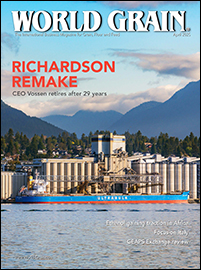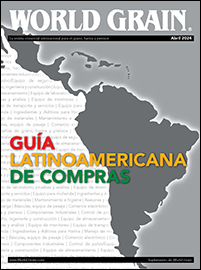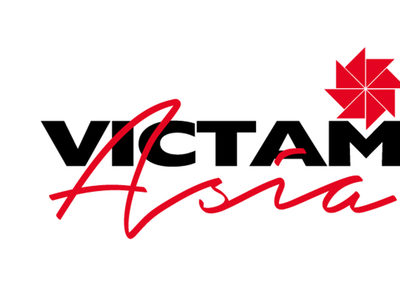Because their job responsibilities and goals don’t always align, and in some cases may actually diverge, there is always potential for conflict and misunderstanding between grain merchandisers and operations managers.
When a good working relationship doesn’t exist between these two parties, grain companies run the risk of business decisions being made off of erroneous assumptions.
In a presentation entitled, “Improving Communications Between Operations and Merchandising” at GEAPS Exchange 2009 in St. Louis, Missouri, Tim Paurus and Rick Dusek of CHS Inc., Inner Grove Heights, Minnesota, U.S., described how a good working relationship between merchandising and operations personnel can enhance company profitability and maintain a strong customer base.
They said merchandising and operations must communicate in an effective manner to procure, sell, handle and ship products that meet each customer’s needs in a safe and efficient manner.
The basic responsibilities of grain merchandisers are setting purchase and sales prices, developing marketing programs, managing commercial customer relationships, managing commodity risk and determining credit worthiness and managing working capital usage of the grain department. In setting the purchase price or the sales price, a merchandiser will use all information available to provide a competitive price to customers and then sell grain based off the highest value to the organization.
In making these price determinations, many factors are taken into account, including competition, quality of grain (purchased, stored or sold), timing of delivery or shipment, mode of shipment and availability of transportation.
Merchants are always thinking, “What is the best way to sell what I have purchased?” or “What is the best sale for what I will purchase?” The merchandiser is analyzing information and then making the best decision as to what direction to take.
Operations managers supervise operations at the terminal with an emphasis on productivity, safety and cost-effectiveness. They are regularly making operational decisions involving employee safety, profit-and-loss results, and maintaining the integrity of the company.
They must focus on things such as: having a working knowledge of government regulations that pertain to the operations of the grain industry; implementing a loading/ unloading/binning plan to effectively control inventory and monitor production; staying abreast of new equipment on the market and changes in technology and how they could improve operations while maintaining a quality work environment; and implementing and maintaining the Environmental Management System and Safety and Health Management System as applicable to the facility.
The merchant is responsible for revenue enhancement and the operator is responsible for cost containment, thus it is easy to see how conflicts may arise.
Paurus, vice-president of terminal operations, and Dusek, director of merchandising, noted that in most organizations, merchandising and operations do not have a reporting function to each other.
They said that merchandising, in its purest form, can stand alone with merchandisers operating in an environment where they are only selling grain based off a weight and inspection certificate. Operations, however, cannot function without some type of merchandising or marketing function leading the effect.
RISK MANAGEMENT
Risk management of grain has significant challenges to the communication between merchandising and operations.
Paurus and Dusek emphasized that this has never been more apparent than during the past two years of unprecedented volatility in the grain markets, when flat market prices of all commodities doubled or tripled, then retreated by more than 50%.
“Working capital availability has required organizations to do things differently than in the past,” Dusek said. “The credit risk attributed to some customers has forced some organizations to re-evaluate who they sell to and how much credit to extend.
“Some of these have had a significant effect on how much company-owned grain you will store and how much grain you can have as hedged and unsold. Plans were made to carry grain for a period of time, and because working capital was needed, grain was sold to get cash.”
He said that as these issues surfaced, it was more important than ever for good communications between merchandising and operations regarding grain quality, type of shipments, timing of shipments and the expectations for each department.
RESOLVING CONFLICT
Paurus and Dusek agreed that resolving conflict and improving communication between merchandisers and operations managers are complicated matters. While there is no one-size-fits all solution, they did recommend that companies look at the following steps: Know what the goals of your organization are. Determine if they are monetary, customer service, innovation, etc. These must be prioritized to make an informed suggestion to merchandising.
Get everyone to start out on the same page. One of the best ways is to define the issue in monetary terms. Everyone understands when additional revenue exceeds cost to produce. Likewise, everyone understands when additional revenue is less than the cost to produce. Getting this accomplished will put merchandising and operations at the same starting point in resolving
the conflict. For example, say a merchant wants to sell a spot shipment that has to be loaded at a specific time. The buyer will pay an extra penny a bushel for the shipment time. The operator has determined that the extra cost is going to be 1.2¢ per bushel. Obviously, in the operator’s mind, making this commitment doesn’t make sense. In this case, it may help to provide a detailed analysis to the merchant of where the additional costs come from, how these were arrived at, and what assumptions were made.
Assuming that everyone agrees the monetary analysis is correct, you should then discuss what other issues may need to be addressed. These could include: needing to make space for additional grain being delivered; the buyer being a consistent customer who needs this shipment; this is the only sale available and customers are selling grain for immediate delivery faster than can be handled in the normal process; and this is the only freight that is immediately available.
Determine if there are other goals that the company must consider beyond profitability. Some of those may be: safety, health and environment; customer service; giving certain customers higher priority; and cost containment.
Paurus and Dusek said one way to get everyone involved in the process is to hold mandatory meetings on a periodic basis. The meetings need to be scheduled at times when it is the most convenient for everyone who needs to attend. The goal of the meeting, they said, should be that when everyone walks out they know specifically what they are responsible for, the deadline for accomplishing assigned tasks and what additional tasks may need to be
assigned. The meetings need to be brief and to the point, led by one individual who keeps everyone on topic, and attendance must be mandatory.
BENEFITS OF WORKING TOGETHER
Paurus and Dusek said that by providing a forum for exchanging ideas and information regarding merchandising wants, operational data and assigning tasks, the following benefits are attainable:
1. Everyone is working toward the same goal. This goal should be defined by the organization. It will be different for each company, but everyone within the company will know what it is.
2. As you develop better and ongoing communications, you should reduce stress and unproductive conflicts within the organization. However, it’s important to remember that not all conflict will be eliminated, as merchandising and operations still have goals within their disciplines that may be in conflict.
3. What ultimately should occur is that all individuals will develop trust in each others abilities, and they will determine who has the best traits to accomplish specific tasks and who moves into the leadership role.
4. Finally, improved communication will enhance company profitability and maintain a strong customer base.





